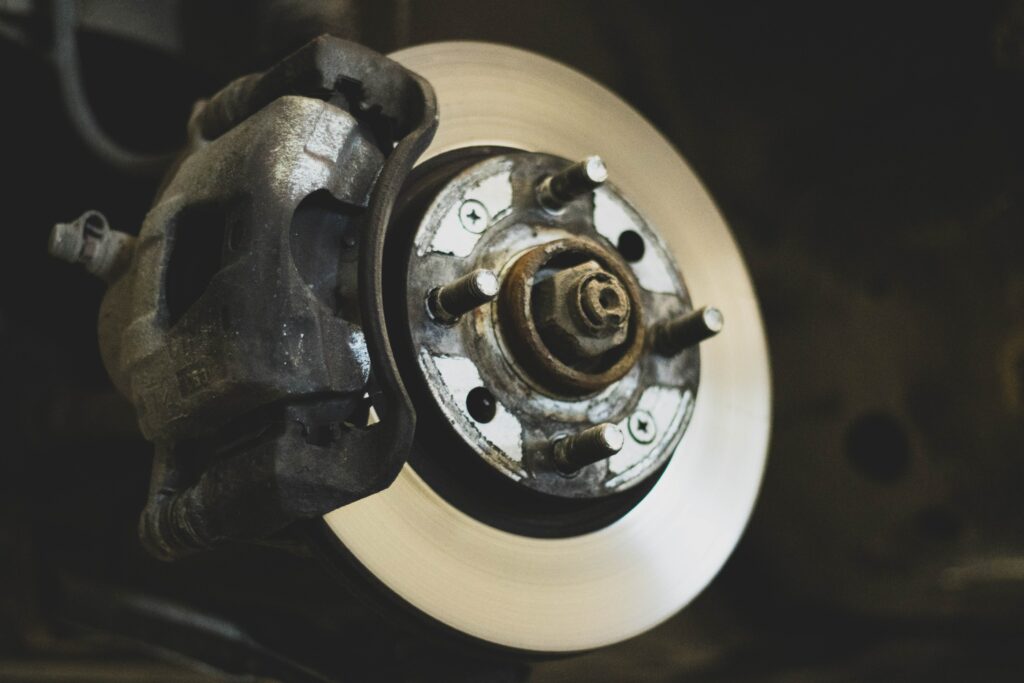Brake pads are an integral part of a vehicle’s braking system, which ensures safe and efficient braking. However, it is uncommon for a brake pad to fall off, creating a potentially hazardous situation for drivers. In this article, we will explore the significance of brake pads in the braking system, discuss the unusual occurrence of a brake pad falling off, and provide an overview of the article structure to guide our discussion.
Brake pads are the friction material that presses against the brake rotors to generate the necessary friction to stop or slow down a vehicle. Their importance in ensuring reliable braking performance cannot be overstated. They withstand extreme heat and pressure, converting kinetic energy into heat and ultimately bringing the vehicle to a halt. Without properly functioning brake pads, the braking system’s efficiency and effectiveness are severely compromised, significantly increasing the risk of accidents.
While brake pad wear is a common issue, the occurrence of a brake pad falling off is relatively rare. Several factors can contribute to this unusual event, including manufacturing defects, improper installation or maintenance, extreme wear and tear, and impact from external factors like road debris or accidents. Understanding these causes and the potential risks associated with a detached brake pad is crucial for every driver’s safety awareness.
To address this topic comprehensively, our article will be structured as follows: we will begin by delving into the importance of brake pads in the braking system and their critical role. We will then explore the unusual occurrence of a brake pad falling off, examining the various causes that can lead to such an event. Next, we will discuss the risks and consequences when a brake pad becomes detached and the potential impact on braking performance.
We will guide you through the immediate actions you should take if you encounter this situation on the road. Additionally, we will highlight the importance of seeking professional assistance and explain the steps involved in addressing the issue. Finally, we will provide preventive measures and maintenance tips to help drivers avoid such incidents in the future.
Contents
Understanding Brake Pads and Their Role
Brake pads are a crucial component of a vehicle’s braking system, responsible for converting kinetic energy into heat through friction, ultimately bringing the vehicle to a stop. Here is a brief explanation of their function, an overview of different types of brake pads, and the expected lifespan of these essential components.
Brake pads press against the brake rotors, generating the necessary friction to slow down or stop the vehicle. This friction between the pads and rotors converts the vehicle’s kinetic energy into heat, dissipating it into the surrounding air.

Several types of brake pads are available in the market, each with its advantages and characteristics. Common types include:
1. Organic Brake Pads: Made from organic materials, such as rubber, carbon compounds, and glass fibers. They offer quieter operation, produce less brake dust, and provide good initial bite. However, they may wear faster and have lower heat resistance than other types.
2. Semi-Metallic Brake Pads: Composed of a blend of metal fibers, such as steel or copper, mixed with organic materials. These pads offer improved heat dissipation, better durability, and superior performance in high-temperature conditions. However, they may produce more brake dust and slightly more noise during operation.
3. Ceramic Brake Pads: Constructed from ceramic compounds, including ceramic fibers, bonding agents, and filler materials. Ceramic pads deliver excellent braking performance, generate minimal noise, produce less brake dust, and offer superior heat resistance. They are often considered the premium choice but can be more expensive than other options.
The expected lifespan of brake pads can vary depending on various factors, including driving conditions, driving style, and the type of brake pads used. Brake pads typically last between 30,000 and 70,000 miles (48,000 to 113,000 kilometers). However, this estimate can differ significantly based on individual driving habits and environmental conditions.
It’s important to note that regular maintenance and inspections are crucial for monitoring brake pad wear. Most brake pads come equipped with wear indicators, which emit a screeching sound when the pads reach their minimum thickness. By paying attention to these signs and conducting routine inspections, drivers can ensure timely replacement, avoiding the risk of worn-out or detached brake pads.
Causes of Brake Pad Detachment
Brake pad detachment, although uncommon, can occur due to various factors. Understanding these causes is crucial in preventing such incidents and maintaining a safe braking system. Here are the key factors that can lead to brake pad detachment:
1. Manufacturing Defects and Quality Control Issues:
Brake pads may sometimes have manufacturing defects or quality control issues. These defects can compromise the integrity of the pad, adhesive bonds, or attachment mechanisms, making them more prone to detachment. Faulty materials or inefficient manufacturing processes can contribute to these defects.
2. Improper Installation or Maintenance:
Improper installation or maintenance practices can also result in brake pad detachment. If the brake pads are not installed correctly, the attachment mechanisms, such as clips, pins, or caliper bolts, may not secure the pads properly. Insufficient torque during installation can lead to loosening over time, increasing the risk of detachment.
3. Extreme Wear and Tear:
Over time, brake pads naturally wear down due to repeated friction against the brake rotors. However, if the brake pads are excessively worn, they may reach a critical thickness where the attachment mechanisms can no longer secure them effectively. This can result in partial or complete detachment of the brake pad from the caliper assembly.
4. Impact from External Factors, such as Road Debris or Accidents:
External factors, including road debris or accidents, can cause sudden impacts to the brake assembly, potentially leading to brake pad detachment. A significant collision or hitting a large object on the road can dislodge the brake pad, compromising its attachment to the caliper.
It is important to note that while brake pad detachment is relatively rare, proper installation, regular maintenance, and inspections are essential preventive measures. Following manufacturer guidelines, using high-quality brake pads, and having them installed by qualified professionals can minimize the risk of detachment. Regular inspections can help identify signs of wear or damage and allow for timely replacement, ensuring optimal brake pad attachment.
Risks and Consequences of Brake Pad Detachment
Brake pad detachment can have severe consequences on the overall braking system and pose significant risks to driver and passenger safety. Understanding these risks and consequences is essential in emphasizing the importance of addressing brake pad detachment promptly. Here are the key risks and consequences associated with a detached brake pad:
1. Impact on Braking Performance:
When a brake pad becomes detached, the vehicle’s braking performance is compromised. The brake pad’s absence means that there is no friction material pressing against the brake rotors to generate the necessary friction for effective braking. As a result, the ability to slow down or bring the vehicle to a stop is significantly reduced.
2. Increased Stopping Distances and Reduced Control:
With a detached brake pad, the vehicle’s stopping distances increase, requiring more time and distance to come to a halt. The driver may experience a noticeable decrease in braking effectiveness, making it challenging to maintain control over the vehicle, especially during emergency braking situations. This can lead to a higher risk of collisions or difficulty avoiding obstacles on the road.
3. Potential Damage to Other Braking System Components:
The detachment of a brake pad can cause additional damage to other braking system components. When a loose or detached brake pad moves within the caliper assembly, it can come into contact with other parts, such as brake rotors, calipers, or brake lines. This contact can result in abrasion, scoring, or even severe damage to these components, further compromising the overall braking system’s functionality.
4. Higher Risk of Accidents and Injury:
The risks associated with a detached brake pad directly translate into a higher risk of accidents and injuries. The compromised braking performance, increased stopping distances, and reduced control can make it difficult to avoid collisions, especially in emergencies. The consequences of such accidents can range from minor fender benders to more severe crashes, potentially resulting in injuries to vehicle occupants or pedestrians.

Addressing brake pad detachment immediately is crucial to mitigate these risks and consequences. If you suspect a brake pad has become detached, you must cease driving the vehicle and seek professional assistance. Promptly replacing the detached brake pad and inspecting the entire braking system for any potential damage will help restore safe braking performance and minimize the risks of accidents or injuries.
Immediate Actions When a Brake Pad Falls Off
Discovering that a brake pad has fallen off can be startling for any driver. It is crucial to take immediate action to ensure safety and prevent further damage. Here are the key steps to follow when a brake pad falls off:
1. Stay Calm and Maintain Control of the Vehicle:
Staying calm and composed is important when you realize a brake pad has fallen off. Keep your focus on maintaining control of the vehicle and safely maneuvering to the side of the road. Avoid sudden or aggressive maneuvers that could further compromise your safety or the safety of other road users.
2. Find a Safe Place to Pull Over and Park:
Once you control the vehicle, find a safe location to pull over and park. Look for a well-lit area away from traffic, if possible. Ensure you are far enough from the flow of vehicles to minimize the risk of an accident. Engage the parking brake to secure the vehicle in place.
3. Inspect the Affected Brake Assembly:
After parking, conduct a visual inspection of the affected brake assembly. Take note of any visible damage or signs of the detached brake pad. Check for loose components, such as clips or bolts that may have caused the detachment. However, avoid touching the hot brake components to prevent burns.
4. Do Not Attempt to Continue Driving Without a Brake Pad:
Under no circumstances should you attempt to continue driving without a brake pad. Driving without a brake pad significantly compromises your ability to stop the vehicle safely, posing a severe risk to yourself and others on the road. If the brake pad has fallen off, the vehicle should not be operated until the issue is resolved.
Once you have completed these immediate actions, it is crucial to seek professional assistance. Contact a towing service or roadside assistance to transport your vehicle to a trusted repair shop. Professional technicians will assess the situation, replace the detached brake pad, and inspect the entire braking system for any further damage or issues that may have occurred due to the detachment.
By following these immediate actions, you prioritize safety and ensure that the necessary steps are taken to effectively address the brake pad detachment. Remember, driving without a brake pad is extremely dangerous, and seeking professional help is essential for restoring the proper functionality of your vehicle’s braking system.
Seeking Professional Assistance
When a brake pad falls off, it is crucial to seek professional assistance to address the issue and ensure the safety of your vehicle. Here are the key steps involved in seeking professional help:
1. Contacting a Towing Service or Roadside Assistance:
If you cannot drive your vehicle safely due to the detached brake pad, contact a towing service or roadside assistance. They will provide the necessary equipment and expertise to transport your vehicle to a secure location or a trusted repair shop.
2. Transporting the Vehicle to a Trusted Repair Shop:
Arrange for your vehicle to be transported to a reputable repair shop specializing in brake system repairs. Choosing a trusted facility with experienced technicians familiar with your vehicle’s make and model is important.
3. Professional Assessment of the Brake System:
A professional technician at the repair shop will comprehensively assess your vehicle’s brake system. They will inspect the brake assembly, including the remaining brake pads, rotors, calipers, and other components. This assessment helps identify any underlying issues, the potential damage caused by the detached brake pad, or other related problems that may need attention.
4. Brake Pad Replacement and Potential System Inspection:
The technician will determine the necessary steps to rectify the brake pad detachment based on the assessment. They will replace the detached brake pad with a new one, ensuring proper installation and secure attachment. Additionally, they may recommend inspecting the entire brake system to ensure its integrity, including checking the remaining brake pads, rotors, and calipers for wear or damage.
During the repair process, the technician may perform other essential tasks, such as cleaning or lubricating brake components, adjusting brake calipers, or bleeding the brake system if necessary. These additional measures help optimize the performance and reliability of the braking system.
By seeking professional assistance, you can rely on the expertise of trained technicians who will properly assess, diagnose, and address the brake pad detachment issue. They have the knowledge and specialized tools to perform brake pad replacement and conduct any necessary system inspections or repairs to ensure the safe operation of your vehicle.
Preventive Measures and Maintenance Tips
To avoid brake pad detachment and ensure the longevity and optimal performance of your vehicle’s braking system, following preventive measures and proper maintenance practices is crucial.
1. Regular Inspection of Brake Pads and System Components:
Perform routine visual inspections of your brake pads and other system components. Look for signs of wear, damage, or any loose parts. Check the thickness of the brake pads and ensure they are within the manufacturer’s recommended specifications. Regular inspections allow for early detection of potential issues and timely replacement of worn-out brake pads.
2. Adequate Installation and Torque Specifications:
During brake pad replacement or maintenance, ensure the new pads are installed correctly and securely. Follow the manufacturer’s guidelines and torque specifications for the attachment mechanisms, such as clips, pins, or caliper bolts. Improper installation can lead to inadequate attachment and increased risks of detachment.
3. Quality Brake Pad Selection and Compatibility with the Vehicle:
Choose high-quality brake pads compatible with your vehicle’s make and model. Quality pads with proper materials and construction offer better performance, durability, and resistance to detachment.
4. Following Manufacturer’s Recommended Maintenance Schedule:
This includes regular brake system inspections, brake fluid checks, and potential flushing or replacement. Following the manufacturer’s guidelines ensures that your vehicle’s braking system is properly maintained, reducing the risk of issues like brake pad detachment.
5. Professional Assistance and Expertise:
When it comes to complex brake system maintenance or repairs, seek the assistance of professional technicians. They have the knowledge, expertise, and specialized tools to perform thorough inspections, identify potential problems, and provide appropriate solutions. Professional maintenance and repairs ensure the safety and reliability of your braking system.

By following these preventive measures and maintenance tips, you can minimize the risk of brake pad detachment and maintain a safe and efficient braking system. Regular inspections, proper installation, quality brake pad selection, and adherence to the manufacturer’s maintenance recommendations are key to ensuring optimal braking performance and the overall safety of your vehicle.
Brake pad fell off
Brake pads are crucial in safely operating a vehicle’s braking system. They provide the necessary friction to bring the vehicle to a stop effectively. However, a detached brake pad can have severe consequences and pose significant risks.
Understanding the risks and consequences associated with a detached brake pad is essential in emphasizing the importance of taking prompt action and seeking professional help. The compromised braking performance increased stopping distances, and reduced control can lead to accidents and injuries. Therefore, staying calm, finding a safe place to pull over and avoiding driving without a brake pad are vital.
Seeking professional assistance is paramount when a brake pad falls off. Contacting a towing service or roadside assistance to transport the vehicle to a trusted repair shop ensures qualified technicians can assess the situation, replace the detached brake pad, and inspect the entire braking system for any potential damage.
Regular maintenance and inspection are crucial to prevent brake pad detachment and maintain a safe braking system. Performing visual inspections, following installation and torque specifications, selecting quality brake pads, and adhering to the manufacturer’s recommended maintenance schedule is essential for long-term brake system health and safety.
More Posts :
Debunking the Myth: Unveiling the Truth About Costco Gas in 2023






